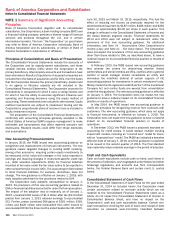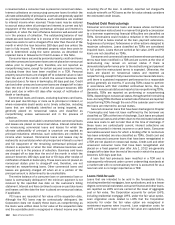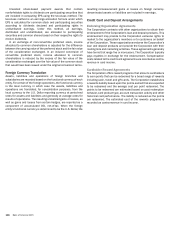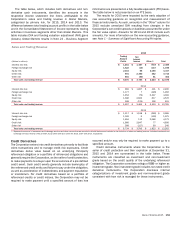Bank of America 2015 Annual Report Download - page 147
Download and view the complete annual report
Please find page 147 of the 2015 Bank of America annual report below. You can navigate through the pages in the report by either clicking on the pages listed below, or by using the keyword search tool below to find specific information within the annual report.Bank of America 2015 145
pricing models, discounted cash flow methodologies or
similar techniques that incorporate the assumptions a
market participant would use in pricing the asset or
liability. This category generally includes retained
residual interests in securitizations, consumer MSRs,
certain ABS, highly structured, complex or long-dated
derivative contracts, certain loans and LHFS, IRLCs and
certain CDOs where independent pricing information
cannot be obtained for a significant portion of the
underlying assets.
Income Taxes
There are two components of income tax expense: current and
deferred. Current income tax expense reflects taxes to be paid or
refunded for the current period. Deferred income tax expense
results from changes in deferred tax assets and liabilities between
periods. These gross deferred tax assets and liabilities represent
decreases or increases in taxes expected to be paid in the future
because of future reversals of temporary differences in the bases
of assets and liabilities as measured by tax laws and their bases
as reported in the financial statements. Deferred tax assets are
also recognized for tax attributes such as net operating loss
carryforwards and tax credit carryforwards. Valuation allowances
are recorded to reduce deferred tax assets to the amounts
management concludes are more-likely-than-not to be realized.
Income tax benefits are recognized and measured based upon
a two-step model: first, a tax position must be more-likely-than-not
to be sustained based solely on its technical merits in order to be
recognized, and second, the benefit is measured as the largest
dollar amount of that position that is more-likely-than-not to be
sustained upon settlement. The difference between the benefit
recognized and the tax benefit claimed on a tax return is referred
to as an unrecognized tax benefit. The Corporation records income
tax-related interest and penalties, if applicable, within income tax
expense.
Accumulated Other Comprehensive Income
The Corporation records the following in accumulated OCI, net-of-
tax: unrealized gains and losses on AFS debt and marketable
equity securities, unrealized gains or losses on DVA on financial
liabilities recorded at fair value under the fair value option, gains
and losses on cash flow accounting hedges, certain employee
benefit plan adjustments, and foreign currency translation
adjustments and related hedges of net investments in foreign
operations. Unrealized gains and losses on AFS debt and
marketable equity securities are reclassified to earnings as the
gains or losses are realized upon sale of the securities. Unrealized
losses on AFS securities deemed to represent OTTI are reclassified
to earnings at the time of the impairment charge. For AFS debt
securities that the Corporation does not intend to sell or it is not
more-likely-than-not that it will be required to sell, only the credit
component of an unrealized loss is reclassified to earnings.
Realized gains or losses on DVA are reclassified to earnings upon
derecognition of the liability. Gains or losses on derivatives
accounted for as cash flow hedges are reclassified to earnings
when the hedged transaction affects earnings. Translation gains
or losses on foreign currency translation adjustments are
reclassified to earnings upon the substantial sale or liquidation
of investments in foreign operations.
Revenue Recognition
The following summarizes the Corporation’s revenue recognition
policies as they relate to certain noninterest income line items in
the Consolidated Statement of Income.
Card income includes fees such as interchange, cash advance,
annual, late, over-limit and other miscellaneous fees, which are
recorded as revenue when earned. Uncollected fees are included
in the customer card receivables balances with an amount
recorded in the allowance for loan and lease losses for estimated
uncollectible card receivables. Uncollected fees are written off
when a card receivable reaches 180 days past due.
Service charges include fees for insufficient funds, overdrafts
and other banking services and are recorded as revenue when
earned. Uncollected fees are included in outstanding loan
balances with an amount recorded for estimated uncollectible
service fees receivable. Uncollected fees are written off when a
fee receivable reaches 60 days past due.
Investment and brokerage services revenue consists primarily
of asset management fees and brokerage income that are
recognized over the period the services are provided or when
commissions are earned. Asset management fees consist
primarily of fees for investment management and trust services
and are generally based on the dollar amount of the assets being
managed. Brokerage income generally includes commissions and
fees earned on the sale of various financial products.
Investment banking income consists primarily of advisory and
underwriting fees that are recognized in income as the services
are provided and no contingencies exist. Revenues are generally
recognized net of any direct expenses. Non-reimbursed expenses
are recorded as noninterest expense.
Earnings Per Common Share
Earnings per common share (EPS) is computed by dividing net
income (loss) allocated to common shareholders by the weighted-
average common shares outstanding, except that it does not
include unvested common shares subject to repurchase or
cancellation. Net income (loss) allocated to common shareholders
represents net income (loss) applicable to common shareholders
which is net income (loss) adjusted for preferred stock dividends
including dividends declared, accretion of discounts on preferred
stock including accelerated accretion when preferred stock is
repaid early, and cumulative dividends related to the current
dividend period that have not been declared as of period end, less
income allocated to participating securities (see below for more
information). Diluted EPS is computed by dividing income (loss)
allocated to common shareholders plus dividends on dilutive
convertible preferred stock and preferred stock that can be
tendered to exercise warrants, by the weighted-average common
shares outstanding plus amounts representing the dilutive effect
of stock options outstanding, restricted stock, restricted stock
units, outstanding warrants and the dilution resulting from the
conversion of convertible preferred stock, if applicable.
























